Portable Thiocholine-Based Sensor for Monitoring Blood Cholinesterase Activity and Detecting Organophosphate and Carbamate Pesticides Using Personal Glucose Meters
Abstract
:1. Introduction
2. Materials and Methods
2.1. Reagents and Apparatus
2.2. Preparation of Solutions
2.2.1. Acetylthiocholine Solution
2.2.2. Phosphate-Buffer Solution (PBS)
2.2.3. Specimen Preparation
2.3. Blood Cholinesterase Analysis Using Corrected PGM Readout
2.3.1. Optimization of Whole Blood ChE Activity Measurement
- Measured result: PGM reading from the reaction tube (blood sample, PBS, and ATCh) after 10 min of incubation.
- Sample blank: PGM reading from the tube containing blood sample and PBS (no ATCh).
- Reagent blank: PGM reading from the tube containing PBS and ATCh (no blood sample).
2.3.2. Dose–Response Analysis of OP and CM Pesticides Using Corrected PGM Readouts
- Corrected PGM control: PGM readout without pesticide exposure.
- Corrected PGM inhibited: PGM readout with pesticide exposure.
2.4. Detection of OP and CM Residues Using Cricket ChE and Corrected PGM Readout
2.4.1. Optimization of Cricket ChE Activity Measurement
- v = reaction rate
- Vmax = maximum reaction rate at saturating substrate levels
- [S] = substrate concentration
- Km = substrate concentration at half of Vmax, indicating enzyme affinity
2.4.2. Pesticide Inhibition Analysis Using Cricket ChE
2.4.3. Sample Preparation for Pesticide Detection
Effect of Methanol on PGM Readouts
Sample Extraction Procedure
2.4.4. Pesticide Detection in Fortified Samples
2.5. Statistical Analysis
3. Results
3.1. Blood Cholinesterase Activity
3.1.1. The Effect of ATCh Concentration and Incubation Time on Blood ChE Activity
3.1.2. Optimal Incubation Time for Pesticide-Induced Blood ChE Activity Inhibition
3.1.3. Effect of OP and CM Pesticide Concentrations on Whole Blood ChE Activity
3.2. Result of OP and CM Residue Detection Using Cricket ChE
3.2.1. Effects of ATCh Concentration and Incubation Time on Cricket ChE Activity
3.2.2. Reproducibility and Variability Analysis
3.2.3. Optimal Incubation Time for Pesticide-Induced Cricket ChE Activity Inhibition
3.2.4. Effect of Methanol Concentration on Cricket ChE Activity
3.2.5. Limit of Detection and Correlation Analysis of Pesticide Inhibition in Standard and Fortified Samples Using the PGM Readout Method
3.2.6. Recovery of Pesticide Residues in Spiked Samples
4. Discussion
4.1. Optimization of Assay Conditions for Thiocholine-Based Detection
4.2. Comparative Analysis of Detection Limits
4.3. Strengths and Limitations
4.4. Implications and Future Directions
4.5. Potential Interferences and Food Matrix Limitations
5. Conclusions
Supplementary Materials
Author Contributions
Funding
Institutional Review Board Statement
Informed Consent Statement
Data Availability Statement
Acknowledgments
Conflicts of Interest
References
- Kaur, N.; Khunger, A.; Wallen, S.L.; Kaushik, A.; Chaudhary, G.R.; Varma, R.S. Advanced Green Analytical Chemistry for Environmental Pesticide Detection. Curr. Opin. Green Sustain. Chem. 2021, 30, 100488. [Google Scholar] [CrossRef]
- Umapathi, R.; Sonwal, S.; Lee, M.J.; Mohana Rani, G.; Lee, E.-S.; Jeon, T.-J.; Kang, S.-M.; Oh, M.-H.; Huh, Y.S. Colorimetric-Based On-Site Sensing Strategies for the Rapid Detection of Pesticides in Agricultural Foods: New Horizons, Perspectives, and Challenges. Coord. Chem. Rev. 2021, 446, 214061. [Google Scholar] [CrossRef]
- Umapathi, R.; Ghoreishian, S.M.; Sonwal, S.; Rani, G.M.; Huh, Y.S. Portable Electrochemical Sensing Methodologies for On-Site Detection of Pesticide Residues in Fruits and Vegetables. Coord. Chem. Rev. 2022, 453, 214305. [Google Scholar] [CrossRef]
- Nehra, M.; Dilbaghi, N.; Marrazza, G.; Kaushik, A.; Sonne, C.; Kim, K.-H.; Kumar, S. Emerging Nanobiotechnology in Agriculture for the Management of Pesticide Residues. J. Hazard. Mater. 2021, 401, 123369. [Google Scholar] [CrossRef]
- Dhiman, S.; Kour, J.; Singh, A.D.; Devi, K.; Tikoria, R.; Ali, M.; Kumar, D.; Ohri, P.; Bhardwaj, R. Impact of Pesticide Application on the Food Chain and Food Web. In Pesticides in the Environment; Sharma, A., Kumar, V., Zheng, B., Eds.; Elsevier: Amsterdam, The Netherlands, 2024; pp. 87–118. [Google Scholar]
- Mordor Intelligence. Organophosphate Insecticides Market Size; Mordor Intelligence. 2025. Available online: https://www.mordorintelligence.com/industry-reports/organophosphate-insecticides-market (accessed on 19 January 2025).
- Mdeni, N.L.; Adeniji, A.O.; Okoh, A.I.; Okoh, O.O. Analytical Evaluation of Carbamate and Organophosphate Pesticides in Human and Environmental Matrices: A Review. Molecules 2022, 27, 618. [Google Scholar] [CrossRef]
- Rohlman, D.; Abdel-Rasoul, G.; Ismail, A.; Hendy, O.; Olson, J.; Bonner, M. SPL16 Health Effects of Organophosphorus Pesticides on Children Working in the Agricultural Industry. Occup. Med. 2024, 74 (Suppl. S1). [Google Scholar] [CrossRef]
- Kumar, D.; Sinha, S.N. Chronic Exposures to Cholinesterase-Inhibiting Pesticides Adversely Affects the Health of Agricultural Workers in India. Environ. Res. 2024, 252 Pt 2, 118961. [Google Scholar] [CrossRef] [PubMed]
- Jaiswal, S.; Singh, B.; Dhingra, I.; Joshi, A.; Kodgire, P. Bioremediation and Bioscavenging for Elimination of Organophosphorus Threats: An Approach Using Enzymatic Advancements. Environ. Res. 2024, 252 Pt 2, 118888. [Google Scholar] [CrossRef]
- Karaboga, S.; Severac, F.; Collins, E.-M.; Stab, A.; Davis, A.; Souchet, M.; Hervé, G. Organophosphate Toxicity Patterns: A New Approach for Assessing Organophosphate Neurotoxicity. J. Hazard. Mater. 2024, 470, 134236. [Google Scholar] [CrossRef]
- Singh, A.; Singh, A.; Singh, A.; Singh, P.; Singh, V.; Singh, Y.; Tuli, H.S.; Abdulabbas, H.S.; Chauhan, A. Chemistry, Metabolism and Neurotoxicity of Organophosphorus Insecticides: A Review. Nat. Environ. Pollut. Technol. 2023, 22, 1867–1880. [Google Scholar] [CrossRef]
- Voros, C.; Dias, J.; Timperley, C.M.; Nachon, F.; Brown, R.C.D.; Baati, R. The Risk Associated with Organophosphorus Nerve Agents: From Their Discovery to Their Unavoidable Threat, Current Medical Countermeasures and Perspectives. Chem.-Biol. Interact. 2024, 395, 110973. [Google Scholar]
- Castro, J.; Sánchez-Brunete, C.; Tadeo, J.L. Multiresidue Analysis of Insecticides in Soil by Gas Chromatography with Electron-Capture Detection and Confirmation by Gas Chromatography-Mass Spectrometry. J. Chromatogr A 2001, 918, 371–380. [Google Scholar]
- Ratnamma, P.; Pallavi, M.S.; Harischandra, N.R.; Devaraj, M.; Nandini, P.; Bheemanna, M.; Badariprasad, P.R.; Paramasivam, M. Simultaneous Determination of Dimethoate and Its Metabolite Omethoate in Curry Leaf Using LC-MS/MS and Risk Assessment. J. Sep. Sci. 2022, 45, 1831–1838. [Google Scholar]
- Lu, S.; Wu, D.; Li, G.; Lv, Z.; Gong, P.; Xia, L.; Sun, Z.; Chen, G.; Chen, X.; You, J.; et al. Facile and Sensitive Determination of N-Nitrosamines in Food Samples by High-Performance Liquid Chromatography via Combining Fluorescent Labeling with Dispersive Liquid-Liquid Microextraction. Food Chem. 2017, 234, 408–415. [Google Scholar] [CrossRef]
- Kumaravel, A.; Aishwarya, S.; Sathiyamoorthi, S. Emerging Technologies for Sensitive Detection of Organophosphate Pesticides: A Review. Curr. Anal. Chem. 2024, 20, 383–409. [Google Scholar]
- Zhu, S.; Qin, S.; Wei, C.; Cen, L.; Xiong, L.; Luo, X.; Wang, Y. Acetylcholine Triggered Enzymatic Cascade Reaction Based on Fe7S8 Nanoflakes Catalysis for Organophosphorus Pesticides Visual Detection. Anal. Chim. Acta 2024, 1301, 342464. [Google Scholar] [CrossRef] [PubMed]
- Li, Y.; Zhang, Z.-Y.; Li, S.-Y.; Gong, X.-Y.; Yang, W.-C. Development of Cholinesterase-Activatable Fluorescent Probes for Pesticide Residue Detection. ACS Agric. Sci. Technol. 2024, 4, 337–344. [Google Scholar]
- Si, P.; Huang, Y.; Wang, T.; Ma, J. Nanomaterials for electrochemical non-enzymatic glucose biosensors. RSC Adv. 2013, 3, 3487–3502. [Google Scholar]
- Cancelliere, R.; Zurlo, F.; Micheli, L.; Melino, S. Vegetable waste scaffolds for 3D-stem cell proliferating systems and low-cost biosensors. Talanta 2021, 223, 121671. [Google Scholar] [CrossRef]
- Kalligosfyri, P.M.; Miglione, A.; Cinti, S. Screen-printing and 3D-printing technologies in electrochemical (bio)sensors: Opportunities, advantages, and limitations. ECS Sens. Plus 2025, 4, 010601. [Google Scholar]
- Schreiner, O.; Trandabat, A.; Aradoaei, M.; Machidon, R.; Chiriac, C.V. (Eds.) Electrochemical sensor for carbon monoxide testing based on carbon nanofiber—Conductive polymer electrodes. In Proceedings of the 2024 IEEE International Conference and Exposition On Electric And Power Engineering (EPEi), Iasi, Romania, 17–19 October 2024. [Google Scholar]
- Lisi, F.; Peterson, J.R.; Gooding, J.J. The Application of Personal Glucose Meters as Universal Point-of-Care Diagnostic Tools. Biosens. Bioelectron. 2020, 148, 111835. [Google Scholar]
- Xiang, Y.; Lu, Y. Using Personal Glucose Meters and Functional DNA Sensors to Quantify a Variety of Analytical Targets. Nat. Chem. 2011, 3, 697–703. [Google Scholar] [PubMed]
- Xing, X.; Yao, L.; Yan, C.; Xu, Z.; Xu, J.; Liu, G.; Yao, B.; Chen, W. Recent Progress of Personal Glucose Meters Integrated Methods in Food Safety Hazards Detection. Crit. Rev. Food Sci. Nutr. 2022, 62, 7413–7426. [Google Scholar]
- Tang, W.; Yang, J.; Wang, F.; Wang, J.; Li, Z. Thiocholine-Triggered Reaction in Personal Glucose Meters for Portable Quantitative Detection of Organophosphorus Pesticide. Anal. Chim. Acta 2019, 1060, 97–102. [Google Scholar] [PubMed]
- Suwannachat, J.; Saenchoopa, A.; Tun, W.S.T.; Patramanon, R.; Daduang, S.; Daduang, J.; Kulchat, S. An Electrochemical AChE-Based Biosensor for Organophosphate Pesticides Using a Modified CuNWs/rGO Nanocomposite on a Screen-Printed Carbon Electrode. Food Chem. 2024, 434, 137431. [Google Scholar]
- Wen, L.; Wang, J.; Liu, Z.; Tao, C.A.; Rao, J.; Hang, J.; Li, Y. A Portable Acetylcholinesterase-Based Electrochemical Sensor for Field Detection of Organophosphorus. RSC Adv. 2023, 13, 6389–6395. [Google Scholar]
- Dong, X.; Tang, Z.; Zhang, H.; Hu, Y.; Yao, Z.; Huang, R.; Bai, J.; Yang, Y.; Hong, W. Ultrasensitive Detection of Organophosphorus Pesticides Using Single-Molecule Conductance Measurement. Anal. Chem. 2023, 95, 9831–9838. [Google Scholar]
- Lamthanh, H.; Roumestand, C.; Deprun, C.; Ménez, A. Side Reaction During the Deprotection of (S-Acetamidomethyl) Cysteine in a Peptide with a High Serine and Threonine Content. Int. J. Pept. Protein Res. 1993, 41, 85–95. [Google Scholar]
- Fang, C.S.; Oh, K.H.; Park, J.; Yang, H. Rapid and Sensitive Electrochemical Detection of Carbaryl Based on Enzyme Inhibition and Thiocholine Oxidation Mediated by a Ruthenium (III) Complex. Electroanalysis 2017, 29, 339–344. [Google Scholar]
- Pundir, C.S.; Chauhan, N. Acetylcholinesterase Inhibition-Based Biosensors for Pesticide Determination: A Review. Anal. Biochem. 2012, 429, 19–31. [Google Scholar]
- Wongta, A.; Hongsibsong, S.; Anand, P.; Jaitum, U.; Sawarng, N.; Wongwilai, W.; Dhumtanom, P. Developing an In-House Colorimetric Method for Detecting Organophosphate and Carbamate Residue Using Cricket Cholinesterase. Chem. Biol. Technol. Agric. 2023, 10, 65. [Google Scholar] [CrossRef]
- Kyi, N.E.M.M.; Samar, M.; Hongsibsong, S.; Sawarng, N.; Pata, S.; Wongta, A. Micro-Electrometric Method for Assessing Cholinesterase Activity in Human Whole Blood. Methods Protoc. 2025, 8, 30. [Google Scholar] [CrossRef]
- Wongta, A.; Anand, P.; Aning, N.A.A.; Sawarng, N.; Hongsibsong, S. Advancing Micro-Electrometric Techniques for the Detection of Organophosphate and Carbamate Residues Using Cricket Cholinesterase. PLoS ONE 2024, 19, e0308112. [Google Scholar] [CrossRef]
- Wongta, A.; Sawang, N.; Tongjai, P.; Jatiket, M.; Hongsibsong, S. The Assessment of Organophosphate Pesticide Exposure Among School Children in Four Regions of Thailand: Analysis of Dialkyl Phosphate Metabolites in Students’ Urine and Organophosphate Pesticide Residues in Vegetables for School Lunch. Toxics 2022, 10, 434. [Google Scholar] [CrossRef]
- Michaelis, L.; Menten, M.L. Die Kinetik der Invertinwirkung. Biochem. Z. 1913, 49, 333–369. [Google Scholar]
- Colović, M.B.; Krstić, D.Z.; Lazarević-Pašti, T.D.; Bondžić, A.M.; Vasić, V.M. Acetylcholinesterase Inhibitors: Pharmacology and Toxicology. Curr. Neuropharmacol. 2013, 11, 315–335. [Google Scholar] [CrossRef]
- Pohanka, M.; Musilek, K.; Kuca, K. Progress of Biosensors Based on Cholinesterase Inhibition. Curr. Med. Chem. 2009, 16, 1790–1798. [Google Scholar] [CrossRef]
- Dhull, V.; Gahlaut, A.; Dilbaghi, N.; Hooda, V. Acetylcholinesterase Biosensors for Electrochemical Detection of Organophosphorus Compounds: A Review. Biochem. Res. Int. 2013, 2013, 731501. [Google Scholar] [CrossRef]
- Xia, S.; Wang, X.; Wang, X.Y.; Liu, Z. A Comparative Study of Sensitivity of Acetylcholinesterase in Detection of Organophosphorus Pesticide Residues. Int. J. Food Eng. 2008, 4, 1–9. [Google Scholar] [CrossRef]
- Deepak, K.S.; Dubey, S.; Goel, S.; Javed, A. A Portable Hand-Held Microfluidic Colorimetric Device for the Detection of Organophosphorus Pesticides. IEEE Sens. J. 2024, 25, 3465–3472. [Google Scholar] [CrossRef]
- Malode, S.J.; Ali Alshehri, M.; Shetti, N.P. Nanomaterial-Based Electrochemical Sensors for the Detection of Pharmaceutical Drugs. Chemosensors 2024, 12, 234. [Google Scholar] [CrossRef]
- González-González, R.B.; Sampaio, G.R.; Torres, E.A.F.S.; Saldanha, T. Fluorescent Probes for Pesticide Detection: Recent Advances and Perspectives. TrAC Trends Anal. Chem. 2019, 118, 1–15. [Google Scholar]
- Lee, J.; Kim, J.; Park, S.; Kim, H.; Jung, W. Development of a Portable Spectrophotometer for On-Site Pesticide Detection. Sensors 2015, 15, 29883–29897. [Google Scholar]
- da Silva, M.R.; Sampaio, G.R.; Torres, E.A.F.S.; Saldanha, T. Recent Advances in Analytical Methods for Pesticide Residue Determination in Food and Environmental Matrices. TrAC Trends Anal. Chem. 2021, 144, 116423. [Google Scholar]
- Anastassiades, M.L.; Lehotay, S.J.; Stajnbaher, D.; Schenck, F.J. QuEChERS Methods for Multiresidue Pesticide Analysis. Anal. Bioanal. Chem. 2003, 375, 134–146. [Google Scholar]
- Oliver, N.; Reddy, M.; Leelarathna, L. Continuous glucose sensor accuracy: Beyond the headline metric. Lancet Diabetes Endocrinol. 2024, 12, 934–938. [Google Scholar]
- Amine, A.; Mohammadi, H. Chapter 14 Electrochemical Biosensors for Heavy Metals Based on Enzyme Inhibition. In Comprehensive Analytical Chemistry; Alegret, S., Merkoçi, A., Eds.; Elsevier: Amsterdam, The Netherlands, 2007; Volume 49, pp. 299–310. [Google Scholar] [CrossRef]
- Štěpánková, Š.; Vorčáková, K. Cholinesterase-Based Biosensors. J. Enzyme Inhib. Med. Chem. 2016, 31 (Suppl. S3), 180–193. [Google Scholar] [CrossRef]
- Gong, Z.; Huang, Y.; Hu, X.; Zhang, J.; Chen, Q.; Chen, H. Recent Progress in Electrochemical Nano-Biosensors for Detection of Pesticides and Mycotoxins in Foods. Biosensors 2023, 13, 140. [Google Scholar] [CrossRef]
- Tsounidi, D.; Soulis, D.; Manoli, F.; Klinakis, A.; Tsekenis, G. AChE-Based Electrochemical Biosensor for Pesticide Detection in Vegetable Oils: Matrix Effects and Synergistic Inhibition of the Immobilized Enzyme. Anal. Bioanal. Chem. 2023, 415, 615–625. [Google Scholar] [CrossRef]
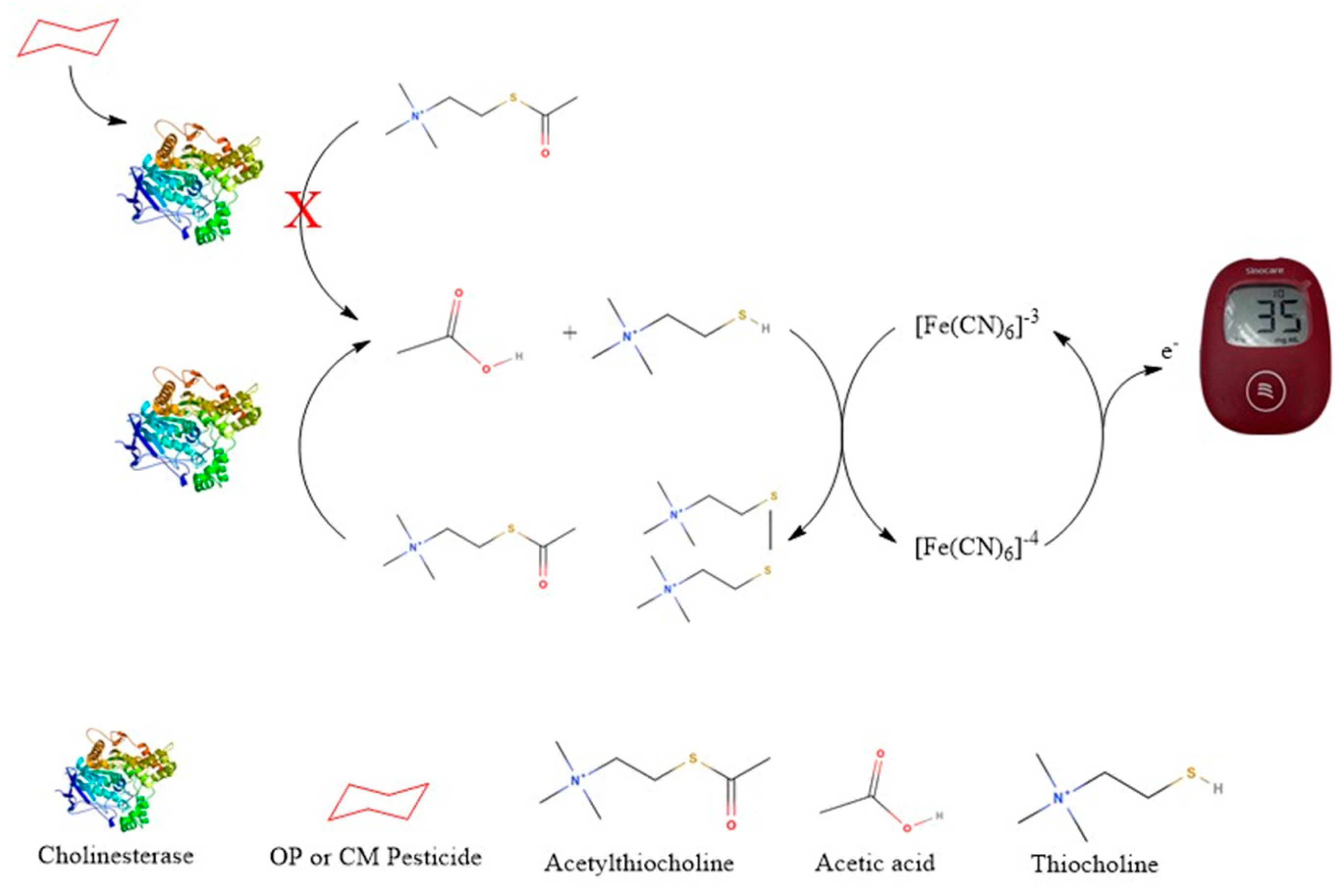
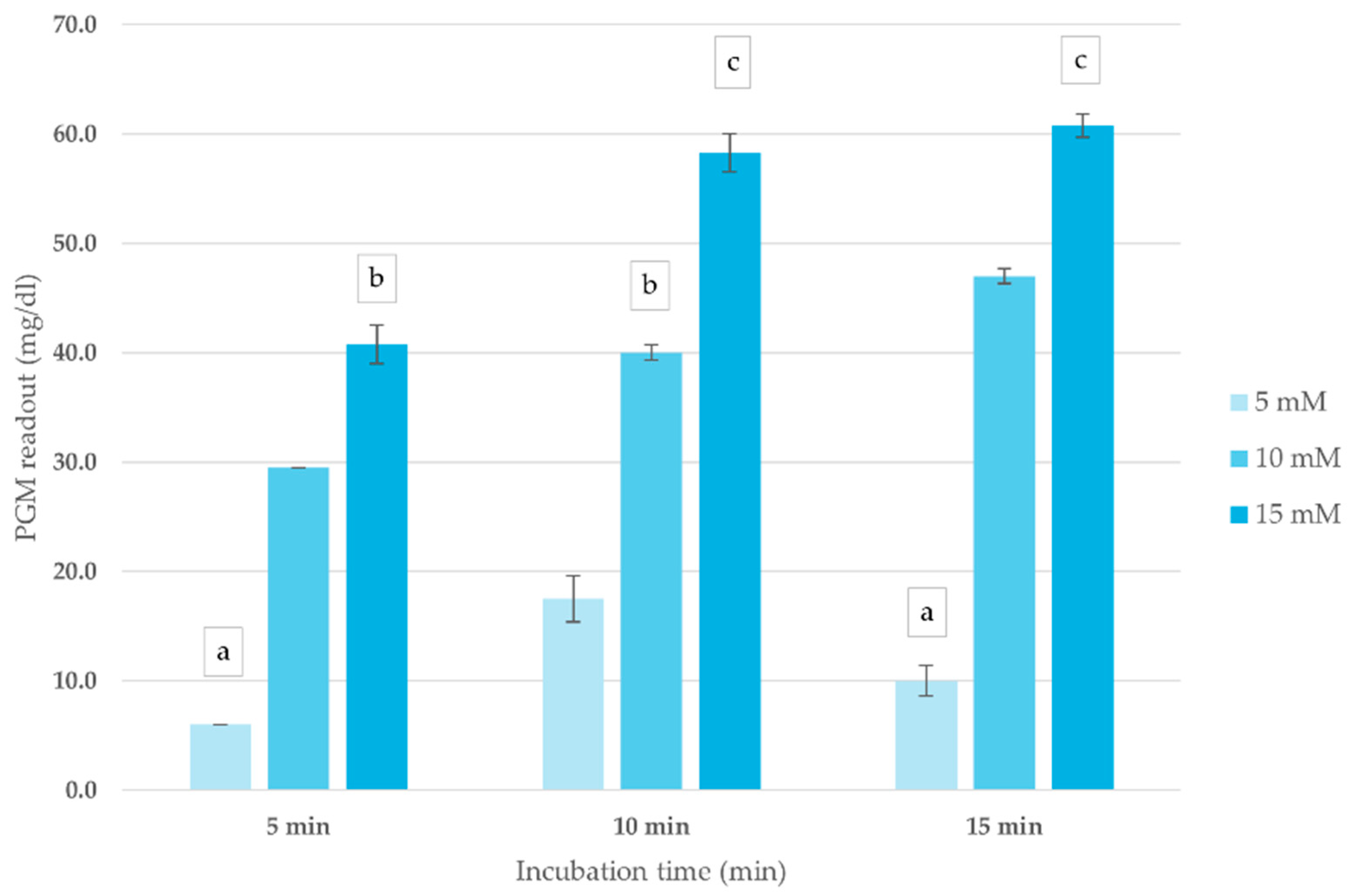
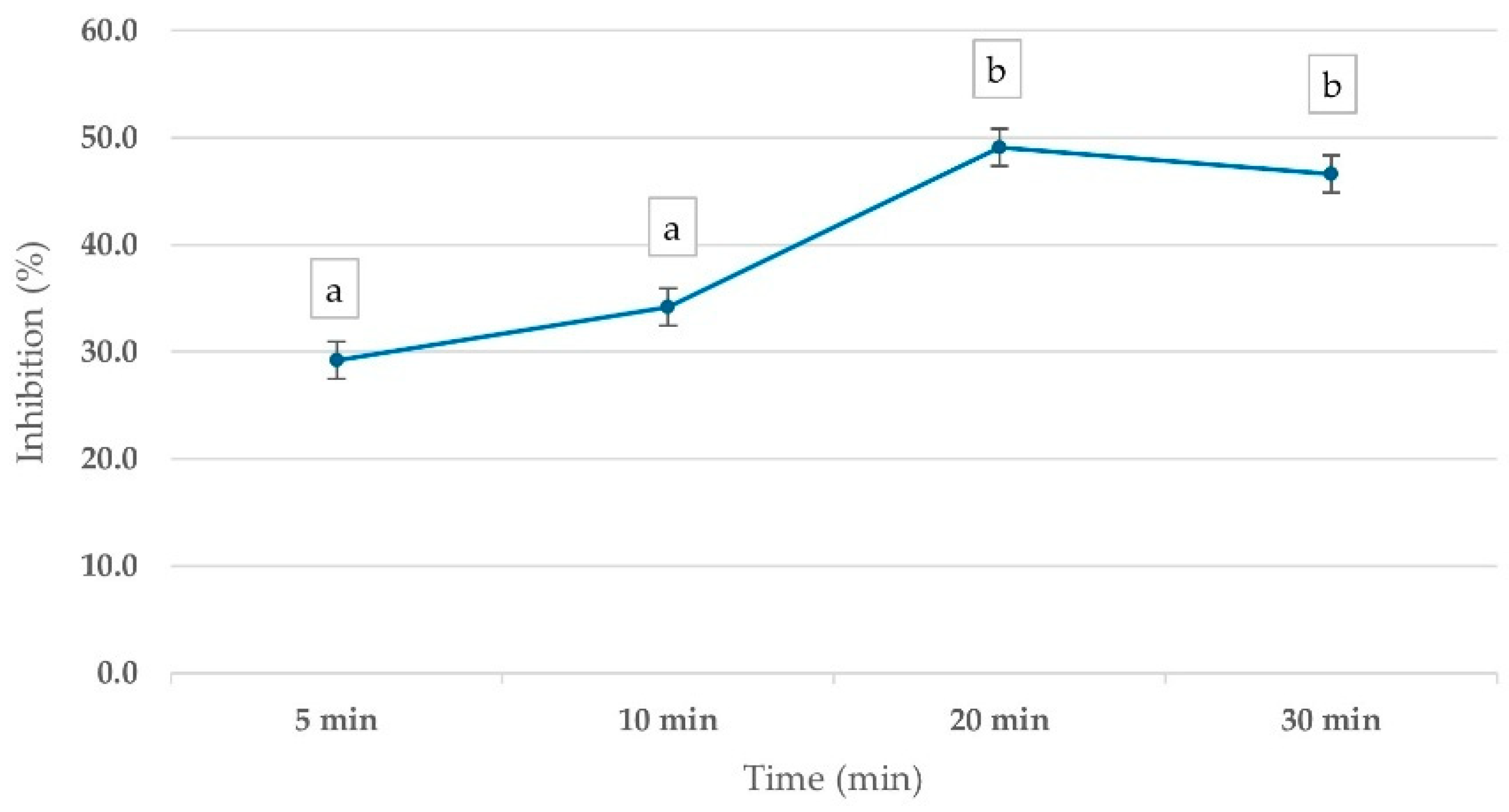
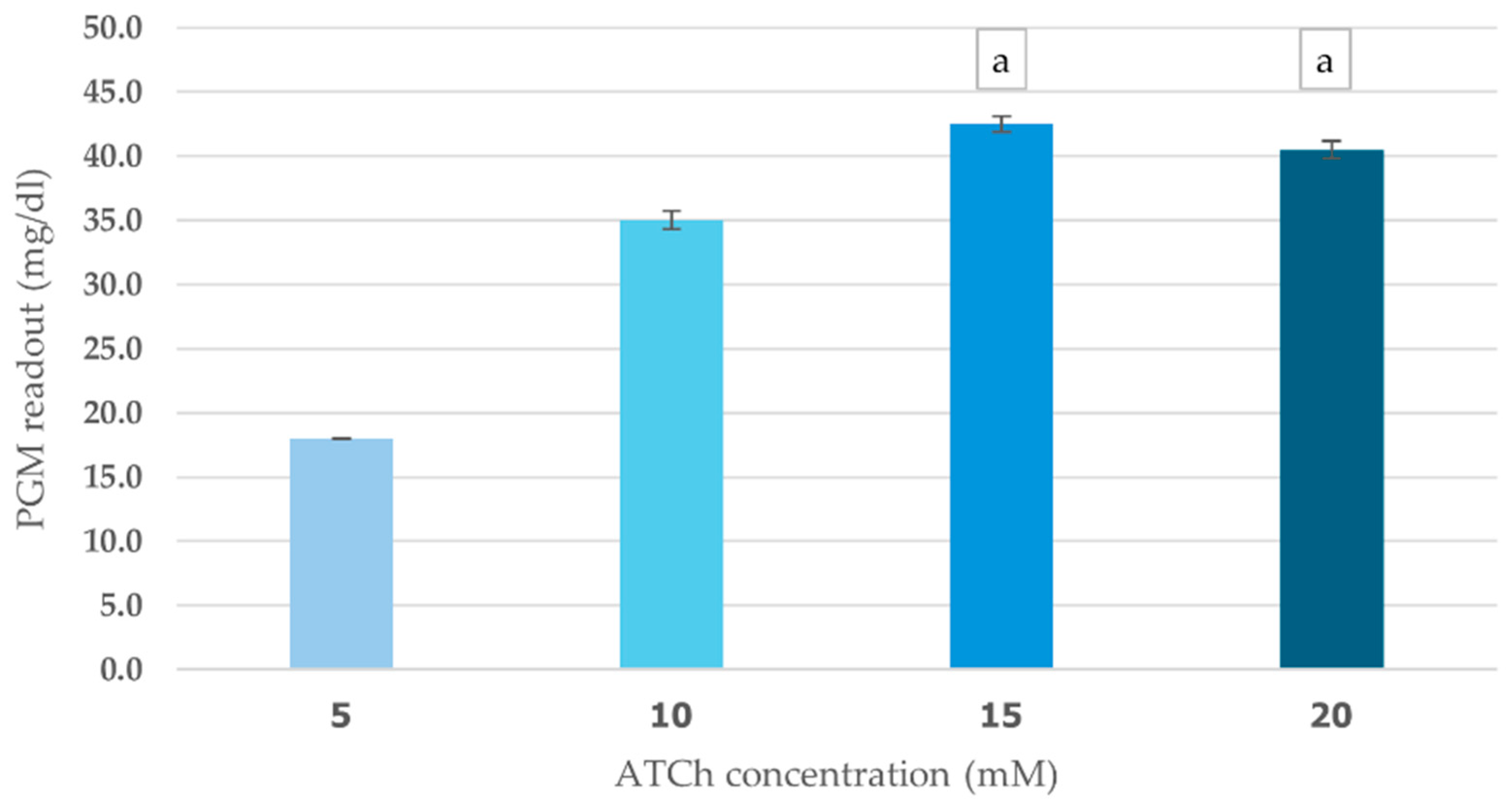
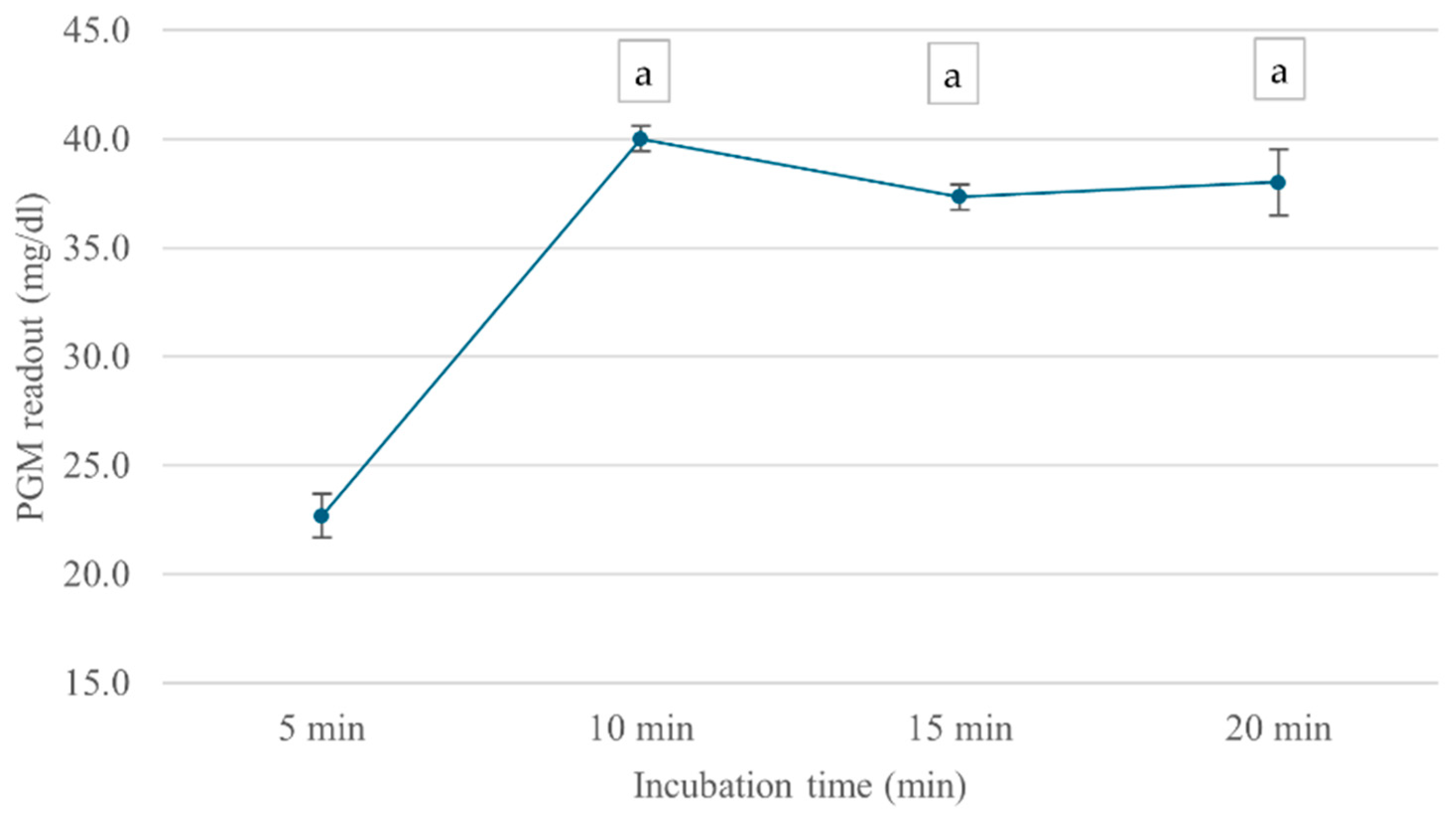
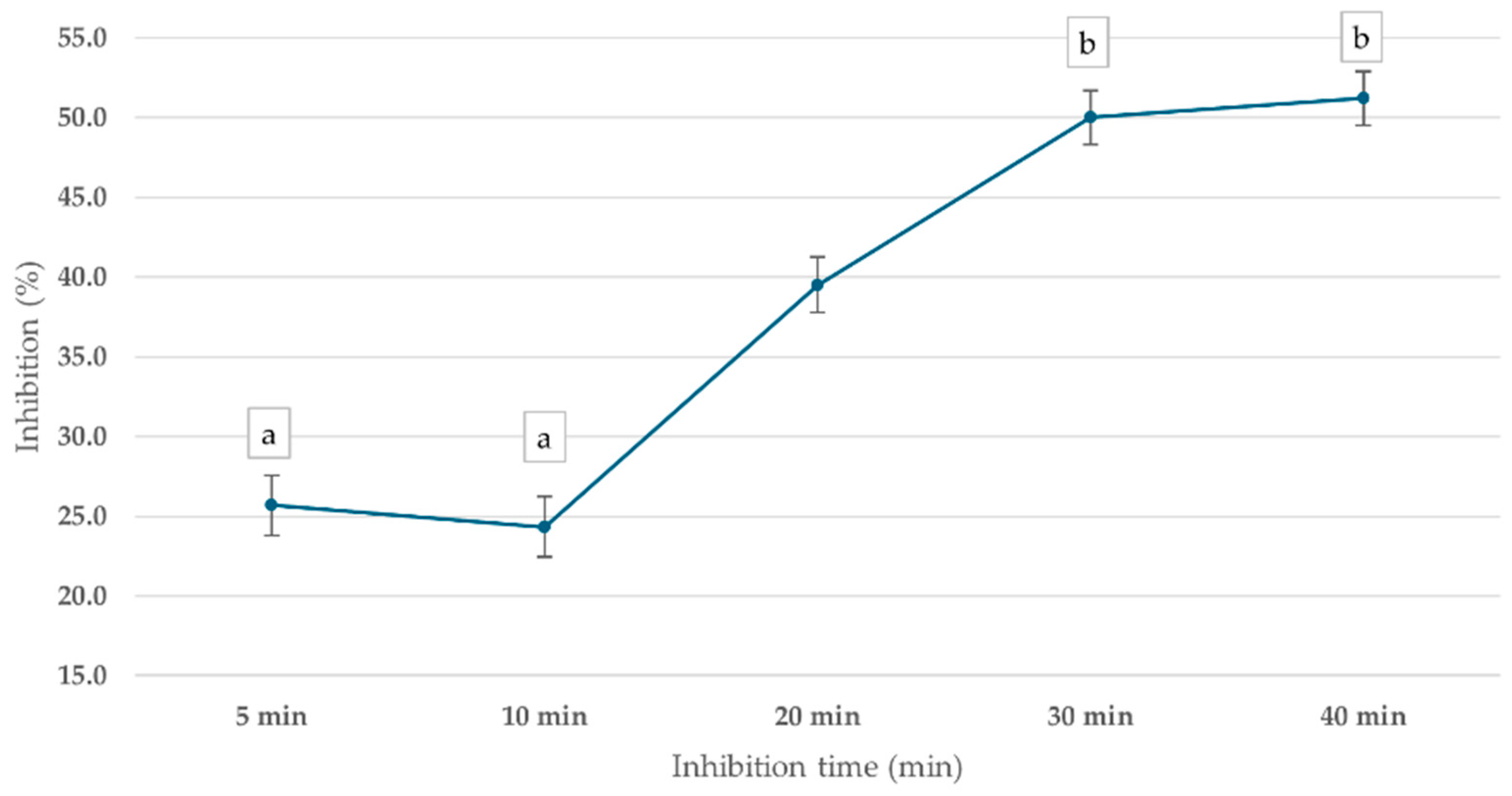
| Insecticide Conc. (ppm) | PGM Read Out (mg/dL) | Inhibition (%) |
|---|---|---|
| Baseline 0.0 | (49 ± 0.7) | |
| Mevinphos | ||
| 1 | 23.0 ± 0.7 * | 53.1 ± 1.4 |
| 0.5 | 27.0 ± 0.7 * | 44.9 ± 1.4 |
| 0.25 | 33.0 ± 0.7 * | 32.7 ± 1.4 |
| 0.05 | 35.5 ± 0.0 * | 27.6 ± 0.0 |
| Carbofuran | ||
| 1 | 27.0 ± 0.7 * | 44.9 ± 1.4 |
| 0.5 | 31.0 ± 0.7 * | 36.7 ± 1.4 |
| 0.25 | 36.0 ± 0.7 * | 26.5 ± 1.4 |
| 0.05 | 38.0 ± 0.7 * | 22.4 ± 1.4 |
| Concentration of MeOH in PBS (%) | ||||||
|---|---|---|---|---|---|---|
| 0 | 1 | 2 | 3 | 4 | 5 | |
| PGM readout (mg/dL) | 43 ± 1 a | 44.5 ± 0.5 a | 42.5 ± 0.5 a | 42.5 ± 1.5 a | 40.5 ± 0.5 a | 41.5 ± 0.5 a |
| Pesticide Name | LOD (ppm) | R | p-Value | |
|---|---|---|---|---|
| Standard | Fortified Sample | |||
| Mevinphos | 0.138 | 0.164 | 0.996 | <0.01 * |
| Carbofuran | 0.113 | 0.127 | 0.999 | <0.01 * |
Disclaimer/Publisher’s Note: The statements, opinions and data contained in all publications are solely those of the individual author(s) and contributor(s) and not of MDPI and/or the editor(s). MDPI and/or the editor(s) disclaim responsibility for any injury to people or property resulting from any ideas, methods, instructions or products referred to in the content. |
© 2025 by the authors. Licensee MDPI, Basel, Switzerland. This article is an open access article distributed under the terms and conditions of the Creative Commons Attribution (CC BY) license (https://creativecommons.org/licenses/by/4.0/).
Share and Cite
Jaitham, U.; Pintakham, T.; Kyi, N.E.M.M.; Samar, M.; Jeeno, P.; Hongsibsong, S.; Pata, S.; Wongta, A. Portable Thiocholine-Based Sensor for Monitoring Blood Cholinesterase Activity and Detecting Organophosphate and Carbamate Pesticides Using Personal Glucose Meters. Foods 2025, 14, 1136. https://doi.org/10.3390/foods14071136
Jaitham U, Pintakham T, Kyi NEMM, Samar M, Jeeno P, Hongsibsong S, Pata S, Wongta A. Portable Thiocholine-Based Sensor for Monitoring Blood Cholinesterase Activity and Detecting Organophosphate and Carbamate Pesticides Using Personal Glucose Meters. Foods. 2025; 14(7):1136. https://doi.org/10.3390/foods14071136
Chicago/Turabian StyleJaitham, Udomsap, Tipsuda Pintakham, Nan Ei Moh Moh Kyi, Muhammad Samar, Peerapong Jeeno, Surat Hongsibsong, Supansa Pata, and Anurak Wongta. 2025. "Portable Thiocholine-Based Sensor for Monitoring Blood Cholinesterase Activity and Detecting Organophosphate and Carbamate Pesticides Using Personal Glucose Meters" Foods 14, no. 7: 1136. https://doi.org/10.3390/foods14071136
APA StyleJaitham, U., Pintakham, T., Kyi, N. E. M. M., Samar, M., Jeeno, P., Hongsibsong, S., Pata, S., & Wongta, A. (2025). Portable Thiocholine-Based Sensor for Monitoring Blood Cholinesterase Activity and Detecting Organophosphate and Carbamate Pesticides Using Personal Glucose Meters. Foods, 14(7), 1136. https://doi.org/10.3390/foods14071136







